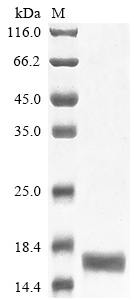Recombinant Mouse Serum amyloid A-1 protein (Saa1) gets produced in E. coli and includes the full length of the mature protein, spanning amino acids 20 to 122. The protein features an N-terminal 6xHis-tag designed to help with purification and detection. SDS-PAGE analysis shows purity levels above 85%, which appears to make it suitable for various research applications.
Serum amyloid A-1 protein likely plays a significant role in the acute phase response, getting involved in lipid metabolism and immune function regulation. It's a key component in chronic inflammation studies. Researchers often examine it in the context of amyloid fibril formation. This protein seems essential for understanding inflammatory processes and how the body responds to injury or infection.
Potential Applications
Note: The applications listed below are based on what we know about this protein's biological functions, published research, and experience from experts in the field. However, we haven't fully tested all of these applications ourselves yet. We'd recommend running some preliminary tests first to make sure they work for your specific research goals.
Mouse Saa1 is an acute-phase protein that requires precise folding, proper oligomerization, and specific tertiary structure for its functional activity in inflammatory responses and receptor binding. The E. coli expression system may not provide the optimal eukaryotic folding environment, and Saa1 may require specific disulfide bond formation or post-translational modifications for full functionality. The N-terminal 6xHis-tag is relatively small (∼0.8 kDa) compared to the mature protein (20-122aa, ∼12 kDa), minimizing steric interference. However, the probability of correct folding with functional bioactivity requires experimental validation, as E. coli-expressed proteins can misfold or lack native conformation.
1. In Vitro Protein-Protein Interaction Studies
This application carries a significant risk without functional validation. Saa1 interactions with receptors or partners require native conformation. If correctly folded and active (verified through binding assays), the protein may identify physiological interactions; if misfolded/unverified, there is a high risk of non-specific binding or tag-mediated artefacts.
2. Antibody Development and Validation
This application is highly suitable as antibody development relies on antigenic sequence recognition rather than functional protein folding. The full-length mature protein provides comprehensive epitope coverage for generating Saa1-specific antibodies. The high purity (>85%) ensures minimal contamination issues.
3. Structural and Biophysical Characterization
These studies are essential for determining folding status. Techniques like circular dichroism spectroscopy, dynamic light scattering, and thermal stability assays can assess protein folding, oligomerization, and stability. If correctly folded, results are valuable; if misfolded, they characterize the recombinant construct.
4. In Vitro Functional Assays
This application carries a significant risk without activity validation. Saa1's cellular effects require native conformation and receptor-binding capability. If correctly folded and active (verified), the protein may be used in dose-response studies; if misfolded/inactive, functional assays will yield biologically meaningless results.
5. Comparative Species Analysis
Meaningful comparative studies require native protein conformation and functional activity. If correctly folded and active (verified), the protein enables valid evolutionary comparisons; if misfolded/unverified, comparative analyses would yield misleading insights.
Final Recommendation & Action Plan
The E. coli-expressed Saa1 with a small His-tag has a moderate probability of correct folding due to the protein's size and minimal tag interference, but experimental validation is crucial. Begin with Application 3 (Structural and Biophysical Characterization) to assess folding quality through techniques like CD spectroscopy and SEC, and validate functionality using receptor-binding or cell-based assays. Applications 1, 4, and 5 require rigorous functional validation before proceeding. Application 2 (antibody development) can proceed immediately. For reliable Saa1 research, confirm bioactivity and consider using refolding protocols or mammalian expression systems if initial validation indicates poor functionality.






